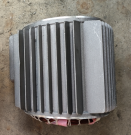


The Rise of Pedestrian Powered Pallet Trucks A Revolution in Material Handling
In the ever-evolving world of logistics and supply chain management, efficiency and sustainability have become paramount goals for businesses. One innovation that has gained significant traction in recent years is the pedestrian powered pallet truck. This versatile piece of equipment not only enhances operational efficiency but also contributes to a more sustainable approach to material handling.
Pedestrian powered pallet trucks, commonly referred to as manual or electric pallet jacks, are designed to transport goods over short distances within warehouses, distribution centers, and retail environments. Unlike traditional forklifts, which require specialized operator training and safety measures, pedestrian powered pallet trucks are user-friendly and accessible to a broader range of employees. Operators simply walk alongside the truck, steering and controlling its movements with minimal effort.
One of the primary advantages of pedestrian powered pallet trucks is their efficiency in maneuvering tight spaces. In busy warehouses where space is often at a premium, these trucks can easily navigate narrow aisles and crowded areas. This not only speeds up the loading and unloading processes but also reduces the likelihood of accidents that can occur in confined settings. The compact design of pedestrian powered pallet trucks allows companies to maximize their storage capabilities, ensuring that products are stored and retrieved with minimal downtime.

Moreover, pedestrian powered pallet trucks come in various models, including manual and electric versions. Manual pallet trucks are operated by human power, requiring the operator to pump the handle to lift the load. These models are ideal for lighter loads and are particularly popular in smaller operations or for tasks that do not require electric assistance. On the other hand, electric pedestrian pallet trucks reduce physical strain significantly by using battery power to lift and move heavy loads effortlessly. This makes them suitable for transporting heavier items, improving productivity and reducing the risk of workplace injuries.
In addition to operational benefits, pedestrian powered pallet trucks also align with sustainability goals, an increasingly important consideration for modern businesses. Many electric models are designed with energy efficiency in mind, utilizing advanced battery technology that requires less frequent charging and has a longer lifespan. This not only minimizes environmental impact but also reduces energy costs for businesses. Furthermore, by shifting to pedestrian powered pallet trucks, companies can decrease their reliance on larger, more fuel-intensive equipment like forklifts, further enhancing their sustainability initiatives.
The ergonomic design of pedestrian powered pallet trucks also caters to the well-being of employees. With features such as cushioned handles and the ability to adjust the height, these trucks reduce strain on the operator's back and arms, promoting a healthier workplace. The ease of use encourages broader worker participation in material handling tasks, fostering a collaborative environment while enhancing overall efficiency.
In conclusion, pedestrian powered pallet trucks represent a significant advancement in the field of material handling. Their combination of efficiency, ease of use, and alignment with sustainability objectives makes them an invaluable tool for businesses seeking to improve their operations. As industries continue to prioritize operational excellence and environmental responsibility, the adoption of pedestrian powered pallet trucks is likely to grow, paving the way for a more efficient and sustainable future in logistics and supply chain management. Embracing this innovative solution will not only enhance productivity but also contribute to a healthier work environment and a greener planet.



